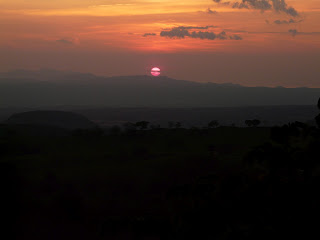Uneventful flights to reach San Jose, Costa Rica arriving about 8:30 PM at our hotel.
We started our tour at the
National Theater, built from 1890-97 in downtown San Jose. Lots of Italian marble and European art with a huge stage for music, dance, and theater. Because of the many earthquakes, the building is under constant maintenance.
National Theater
Our guide, Jorge, introduced us to Costa Rica. They have much to be proud of: the longest democracy in Central America, a 98% literacy rate, a national health-care program, no need for an army, and a strong emphasis (as we would see during the trip) for the ecology. The country is well-known for it's Eco-tourism hosting 2 and 1/2 million tourists per year.
We visited the
National Museum with a nice butterfly pavilion and some interesting artifacts from the ancient Indian cultures: ornate metastases, gold figures and burial pottery. It was a simple museum built in an old military fort, next to the Parliament building.
We then left the city and climbed the hills out of the Central Valley to the
Doka Estate, a 100 year old coffee plantation. Coffee, bananas, and pineapple are Costa Rica's primary exports. Coffee ripens here between November and Feburary. The beans are handpicked when they are red. They put the beans in a large vat of water - high grade beans sink and low grade beans float. They then peel the outer layer of the bean by machine and then ferment the bean in water to remove the outer layer of sugar. After that the beans are dried in the sun for five days, raking them every 30 minutes. Finally they are put in a drying machine for a day, the then stored in bags for a least 3 months. These green beans are then sold to the coffee roasters. For a light roast, it takes about 15 minutes and a dark roast about 20 minutes.
From the plantation, we went up the continental divide toward the Caribbean side, passing through a tropical cloud forest (with appropriate clouds). We stopped along the way for various treats: strawberries,
Granadilla fruit (like a pomegranate) and sour cream cookies. We stopped for the
La Paz Waterfall and at another local restaurant with four species of hummingbird outside. Our room tonight is just outside a wildlife preserve. On way, Jorge, was informing us that it was fairly primitive and that we would have to sign up for when we wanted to take a shower - all in joke.


.jpg)

















.jpg)



_edTMP-1_edited-1.jpg)
